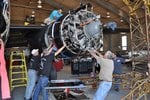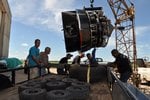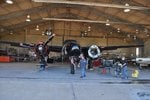Navigation
Install the app
How to install the app on iOS
Follow along with the video below to see how to install our site as a web app on your home screen.
Note: This feature may not be available in some browsers.
More options
You are using an out of date browser. It may not display this or other websites correctly.
You should upgrade or use an alternative browser.
You should upgrade or use an alternative browser.
CAF B-26 blew an engine
- Thread starter Donivanp
- Start date
Ad: This forum contains affiliate links to products on Amazon and eBay. More information in Terms and rules
More options
Who Replied?Could anyone please explain the term "blew an engine"?
What exactly happened? Oil leak and seizure? Gasket failure? It doesn't appear to have caught fire.
As an aside, I recently read that the reason given for wing spar failures in Vietnam was dive-bombing tactics and the constant taxying with heavy wing ordnance over rough landing fields. The plane wasn't designed for steep dive bombing and was meant for paved runways.
What exactly happened? Oil leak and seizure? Gasket failure? It doesn't appear to have caught fire.
As an aside, I recently read that the reason given for wing spar failures in Vietnam was dive-bombing tactics and the constant taxying with heavy wing ordnance over rough landing fields. The plane wasn't designed for steep dive bombing and was meant for paved runways.
Airframes
Benevolens Magister
Always sad to hear when a 'warbird' has a major problem. Hopefully, another engine can be fitted, although the operators must be a bit p*ssed off.
bobbysocks
Chief Master Sergeant
Could anyone please explain the term "blew an engine"?
What exactly happened? Oil leak and seizure? Gasket failure? It doesn't appear to have caught fire.
the term is used to mean sever engine damage. it was usually from a connecting rod breaking and going through the crankcase and/or the now disconnected piston blowing the cylinderhead off or almost. it has come to mean the engine is pretty much a total or will take extensive repair to get back into operating condition. from the article the engine is a write off...completely unrebuildable...so it was probably a connecting rod problem...my best guess.
Could anyone please explain the term "blew an engine"?
What exactly happened? Oil leak and seizure? Gasket failure? It doesn't appear to have caught fire.
As an aside, I recently read that the reason given for wing spar failures in Vietnam was dive-bombing tactics and the constant taxying with heavy wing ordnance over rough landing fields. The plane wasn't designed for steep dive bombing and was meant for paved runways.
The only wing spar failures I'm aware of, 2, one in Vietnam, one at Eglin AFB, Fl. could mostly be laid to blame on WW2 aircraft still in service use 20 years later, no aircraft was designed for that.
I would have doubts about the excuse of a WW2 era attack aircraft being designed for paved runways only.
GregP
Major
Yes, probably a rod, pushrod or connecting rod.
If the engine just "made metal" and the bits and pieces got in the main nearings, then it is rebuildable ... just disassemble, clean it up, replace the bearings, and replace any broken or worn parts.
But when the crankcase is unusable, something mechanicaly very bad happened that damaged the case, the crankshaft, both, and/or even more.
If the engine just "made metal" and the bits and pieces got in the main nearings, then it is rebuildable ... just disassemble, clean it up, replace the bearings, and replace any broken or worn parts.
But when the crankcase is unusable, something mechanicaly very bad happened that damaged the case, the crankshaft, both, and/or even more.
Last edited:
The second picture down...I'm no expert, but won't they damage the cowl flaps and stuff if they set her down like that?
Yes, probably a rod, pushrod or connecting rod.
The the engine kust "made metal" and the bits and pieces got in the main nearings, then it is rebuildable ... just disassemble, clean it up, replace the bearings, and replace any broken or worn parts.
But when the crankcase is unusable, something mechanicaly very bad happened that damaged the case, the crankshaft, both, and/or even more.
Looks pretty clean if its thrown a leg out of bed. A bent pushrod isn't usually catastrophic.
GregP
Major
Not it isn't and the engine as-removed doesn't look bad. But if it is not rebuildable, then there was catastrophic damage of SOME sort.
The most likely cause is big pieces of metal, not small bearing debris.
The most likely cause is big pieces of metal, not small bearing debris.
Unless they're talking about not economically repairable, which brings the amount of damage down. Crankshaft problems could easily amount to $60k of expense, and would mean it wouldn't be accepted as a core, and essentially a 'write-off'.
Either way, something bad happened inside that engine
Either way, something bad happened inside that engine
Regarding the B-26 in Vietnam, in Setup What the Air Force Did in Vietnam and Why (Air University press, June 1991.)
It mentions that the initial B-26s sent over in 1961 were 8 ex-AF Reserve unit planes.
By 1964:
"Problems developed with the wing spars of both the T-28s and B-26s. In several cases, the wings fell off after sharp pullouts or simply broke off in flight due to structural fatigue. Neither of these planes had been designed to operate from unimproved fields, and a major cause of wing fatigue in the B-26s was taxiiing the aircraft with 750-pound bombs attached to specially designed racks slung beneath the wings. Moreover, the B-26 had been designed in the late 1930's as a medium-altitude, "horizontal" bomber, not a dive bomber, and steep pullouts often spelled disaster. Likewise, T-28s (training aircraft modified especially for the air commandos) had begun losing their wings at an increased rate in 1963 and 1964. Air power may, in official doctrine, be flexible, but aircraft are not always so."
P.77, Earl Tilford, Jr.
It mentions that the initial B-26s sent over in 1961 were 8 ex-AF Reserve unit planes.
By 1964:
"Problems developed with the wing spars of both the T-28s and B-26s. In several cases, the wings fell off after sharp pullouts or simply broke off in flight due to structural fatigue. Neither of these planes had been designed to operate from unimproved fields, and a major cause of wing fatigue in the B-26s was taxiiing the aircraft with 750-pound bombs attached to specially designed racks slung beneath the wings. Moreover, the B-26 had been designed in the late 1930's as a medium-altitude, "horizontal" bomber, not a dive bomber, and steep pullouts often spelled disaster. Likewise, T-28s (training aircraft modified especially for the air commandos) had begun losing their wings at an increased rate in 1963 and 1964. Air power may, in official doctrine, be flexible, but aircraft are not always so."
P.77, Earl Tilford, Jr.
FLYBOYJ
"THE GREAT GAZOO"
Regarding the B-26 in Vietnam, in Setup What the Air Force Did in Vietnam and Why (Air University press, June 1991.)
It mentions that the initial B-26s sent over in 1961 were 8 ex-AF Reserve unit planes.
By 1964:
"Problems developed with the wing spars of both the T-28s and B-26s. In several cases, the wings fell off after sharp pullouts or simply broke off in flight due to structural fatigue. Neither of these planes had been designed to operate from unimproved fields, and a major cause of wing fatigue in the B-26s was taxiiing the aircraft with 750-pound bombs attached to specially designed racks slung beneath the wings. Moreover, the B-26 had been designed in the late 1930's as a medium-altitude, "horizontal" bomber, not a dive bomber, and steep pullouts often spelled disaster. Likewise, T-28s (training aircraft modified especially for the air commandos) had begun losing their wings at an increased rate in 1963 and 1964. Air power may, in official doctrine, be flexible, but aircraft are not always so."
P.77, Earl Tilford, Jr.
Earl Tilford was an Intel officer during the Vietnam War era. He's written some great articles but he does not come from an air ops or maintenance background AFAIK so I question the statement about unimproved fields and the wing stores attributing to these wing failures, especially on the B-26. The B-26 was operated during the Korean War from unimproved fields with no problems although they did not have the additional wing stores seen on the Vietnam era birds. Prior to mods as such engineering officers determine the stresses placed on aircraft and I'm sure unimproved field ops were included. Despite the B-26 (A-26) being designed during the 1930s as the article says (The A-26 first flew in 1942) there were plenty of unimproved fields in operation during this period and were probably the majority of airfields in existence at the time.
Unless these aircraft were being taxied extremely rough, through potholes at excessive speeds (that would be fun to do with a full bomb load) or returning to base with their pylons full on a consistent basis (that might even be prohibited in the -1) I doubt this was a contributing factor to these wing failures.
Last edited:
Shortround6
Lieutenant General
I am not sure but they may be confusing the Martin B-26 being designed in the 1930s.
"March 11, 1939, the Air Corps issued Proposal No. 39-640 for the design of a new medium bomber." this lead to the Martin B-26.
Douglas was playing with the A-20 in the 1930s starting in 1936 but the A-26 wasn't really worked on until fall/winter of 1940. A small distinction perhaps but the laminar flow wing and double slotted flaps are not features of the even the late 30s.
"March 11, 1939, the Air Corps issued Proposal No. 39-640 for the design of a new medium bomber." this lead to the Martin B-26.
Douglas was playing with the A-20 in the 1930s starting in 1936 but the A-26 wasn't really worked on until fall/winter of 1940. A small distinction perhaps but the laminar flow wing and double slotted flaps are not features of the even the late 30s.
FLYBOYJ
"THE GREAT GAZOO"
Yep!! As with the B-26, unless you're taxing at near takeoff speeds will a full complement of bombs hanging off your external stores (and the stress loads of those stores determined prior to their installation) while thumping through potholes and craters, you're not stressing wings. I had one occasion where I flew on an aircraft with live ordnance and we taxied slow and carefully. In both cases shown, I'd bet dollars to donuts those aircraft were losing wings because of the way they were being flown, not because they were carrying bombs over a dirt strip. I know of another famous trainer that had a habit of losing wings because of 'operator error' as well...The guy who wrote that article obviously hasn't seen how a T-28 is built. May not be designed for unimproved strips, but it is designed for 4carrier training, so wing attaches are pretty strong.
at6
1st Sergeant
Hoping that they will be able to obtain a replacement engine.
GregP
Major
All it takes is money. There are engines around and Ray Anderson is the best radial rebuilder in the business.
All it takes is money. There are engines around and Ray Anderson is the best radial rebuilder in the business.
$60k is what they're looking at for this one.
GregP
Major
That may buy an engine, but will not include both the engine and an overhaul of same.
From the O.P. article:
Apparently it happened on landing:
She has served her community well, but now the Lady Liberty sponsorship group is seeking additional donors, sponsors and benefactors to help raise the necessary US$60,000 to replace the bad engine, and get the Invader flying again.
Apparently it happened on landing:
Ediger said Lady Liberty was attending an air show in early June at Hutchinson, Kanas, when she lost an engine on landing. "We were invited to go up there," she said. "When they landed at the airport it was just a big puff of black smoke."
Users who are viewing this thread
Total: 1 (members: 0, guests: 1)



